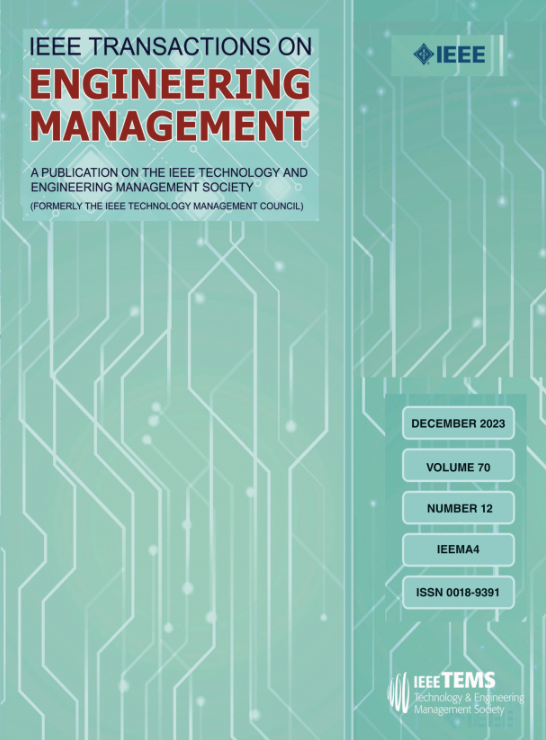The Evolution of Complex Global Innovation Collaboration Network: A Multilevel Analysis of a CoPS Industry 2001–2020
IF 4.6
3区 管理学
Q1 BUSINESS
引用次数: 0
Abstract
Global innovation collaboration networks (GICNs) constitute a fundamental component of the innovation ecosystem and significantly contribute to the advancement of complex products and systems (CoPS) in the domain of engineering management. Despite their significance, existing research has not adequately captured the intricate dynamics of GICNs, particularly from an evolutionary perspective. This study seeks to fill this gap by employing a holistic approach to analyze the complexity and evolutionary characteristics of a representative CoPS industry, across macronetwork, meso-module, and micromotif levels. Utilizing global patent data from 2001 to 2020 pertaining to chip manufacturing, our analysis identifies distinct collaborative patterns across the macro, meso, and micro levels within GICNs. At the macro level, there is a discernible shift towards a distributed structure, epitomized by a “big center, multicenters, decentralization” trend. The meso level exhibits a progression towards a “loosely coupled” configuration of technical submodules, reflecting a specialized division of labor. Notably, the micro level demonstrates a significant centralization in collaborative innovation, with enterprises playing a pivotal role. This investigation provides an exhaustive empirical examination of GICNs within the CoPS industry and offers novel insights into the evolution of such networks. Furthermore, it furnishes actionable recommendations for policymakers and engineering managers seeking to navigate the complexities of CoPS innovation, thus providing a strategic roadmap for collaboration and innovation management.复杂全球创新协作网络的演化:基于cop产业2001-2020的多层次分析
全球创新协作网络(GICNs)是创新生态系统的基本组成部分,对工程管理领域复杂产品和系统(cop)的进步做出了重要贡献。尽管它们具有重要意义,但现有的研究并没有充分捕捉到gicn的复杂动态,特别是从进化的角度来看。本研究试图通过采用整体方法来分析具有代表性的cop产业的复杂性和进化特征,跨越宏观网络、中观模块和微观基序水平来填补这一空白。利用2001年至2020年与芯片制造相关的全球专利数据,我们的分析确定了GICNs内部宏观、中观和微观层面的独特合作模式。在宏观层面上,有一个明显的向分布式结构的转变,集中体现为“大中心、多中心、去中心化”的趋势。中观层次展示了向技术子模块的“松散耦合”配置的发展,反映了专业化的分工。值得注意的是,微观层面的协同创新表现出明显的集中化,企业扮演着关键角色。这项调查对cop行业内的gicn进行了详尽的实证研究,并对此类网络的发展提供了新的见解。此外,它还为决策者和工程管理人员提供了可行的建议,以应对cop创新的复杂性,从而为合作和创新管理提供了战略路线图。
本文章由计算机程序翻译,如有差异,请以英文原文为准。
求助全文
约1分钟内获得全文
求助全文
来源期刊

IEEE Transactions on Engineering Management
管理科学-工程:工业
CiteScore
10.30
自引率
19.00%
发文量
604
审稿时长
5.3 months
期刊介绍:
Management of technical functions such as research, development, and engineering in industry, government, university, and other settings. Emphasis is on studies carried on within an organization to help in decision making or policy formation for RD&E.
 求助内容:
求助内容: 应助结果提醒方式:
应助结果提醒方式:


